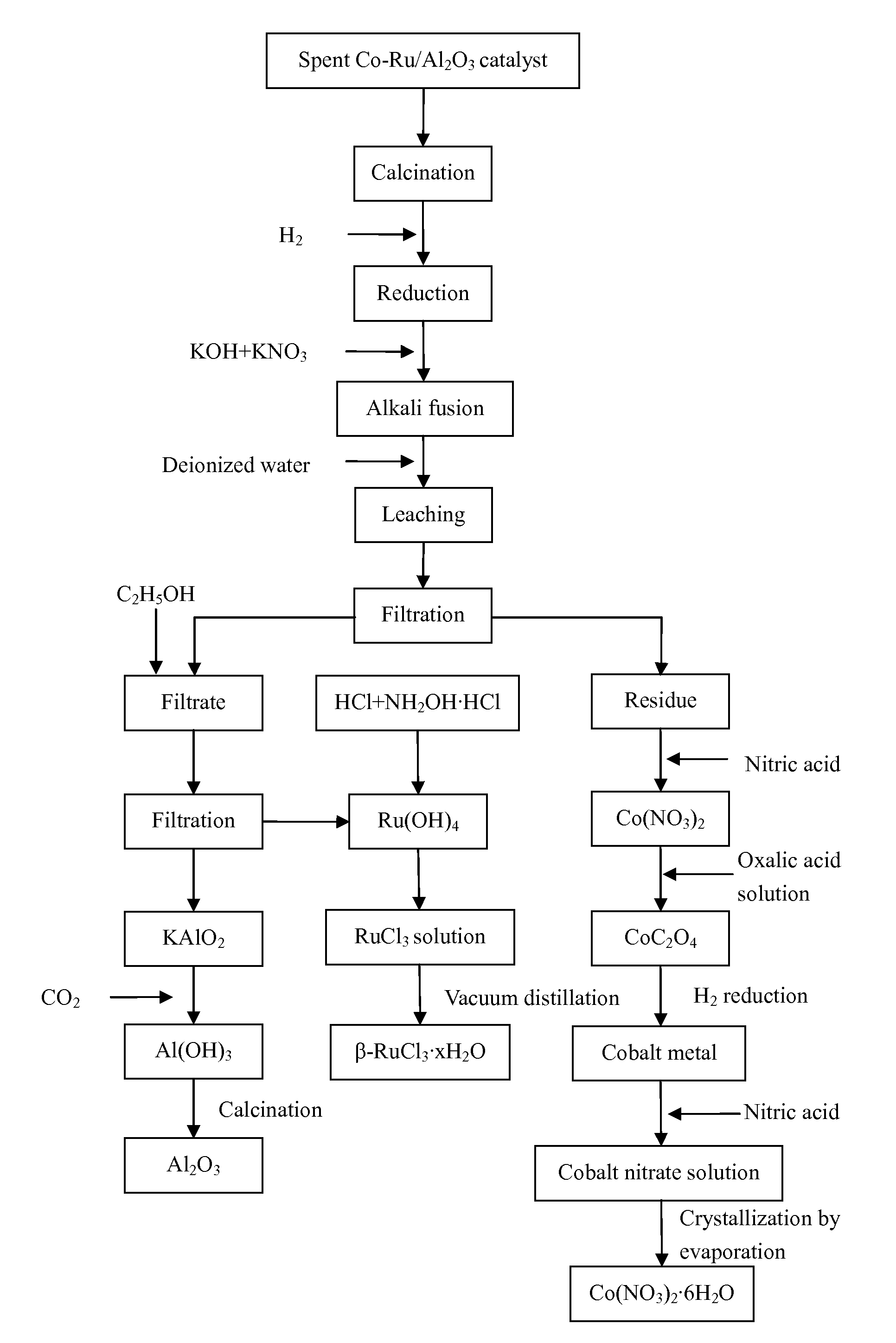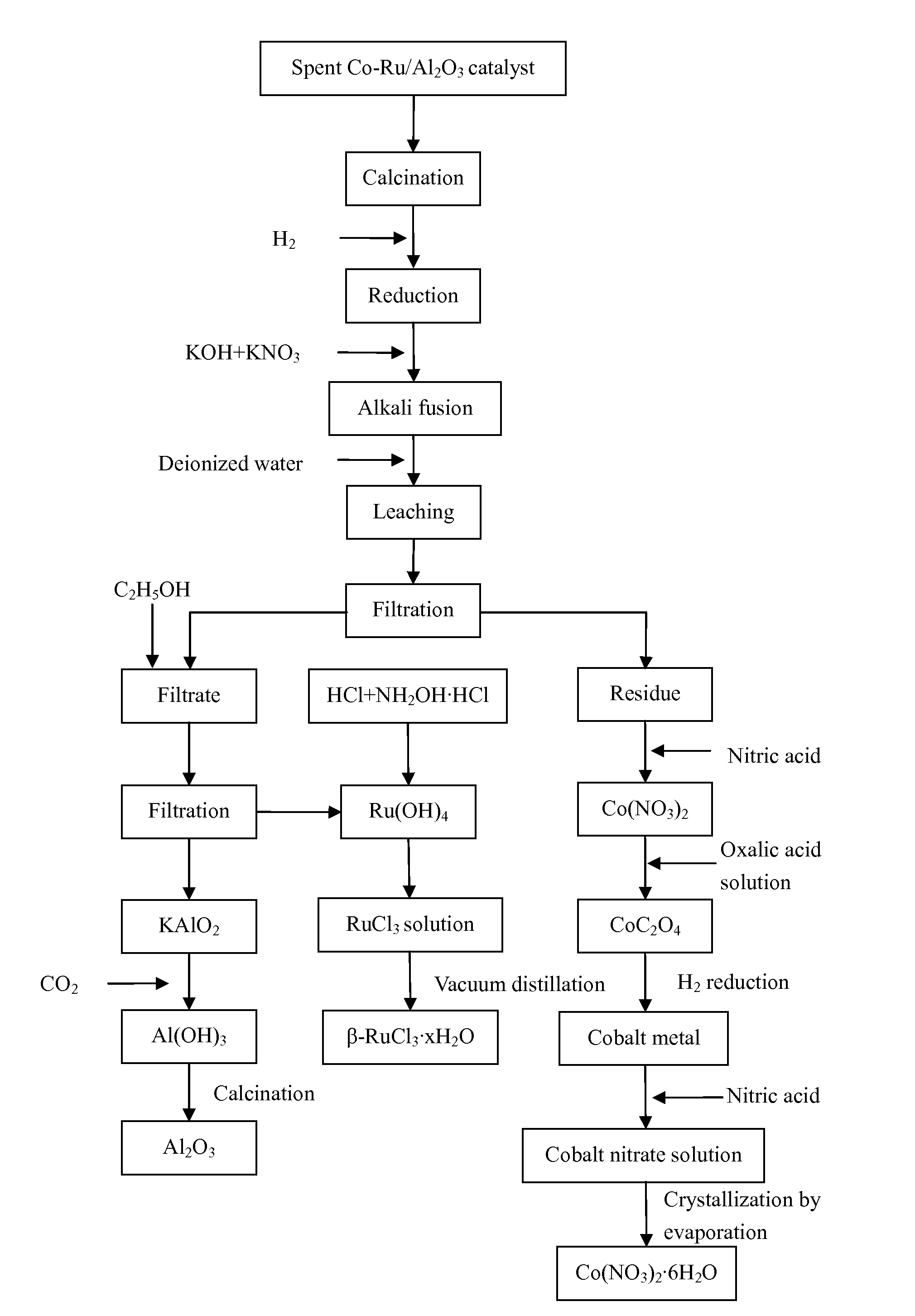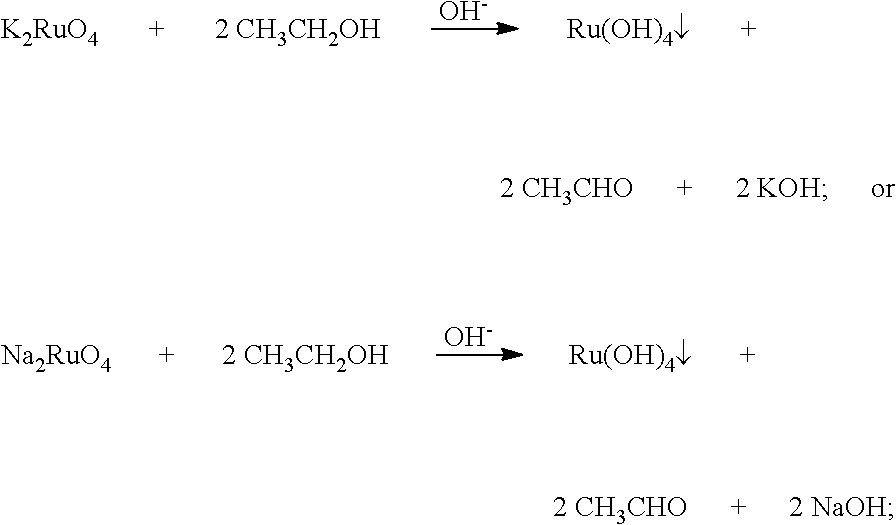Process for recovery of cobalt, ruthenium, and aluminum from spent catalyst
a cobalt and catalyst technology, applied in the field of recovery methods for cobalt, ruthenium and aluminum from spent co, can solve the problems of low cobalt recovery rate, high price, and limited application, and achieve the effect of safe and efficien
- Summary
- Abstract
- Description
- Claims
- Application Information
AI Technical Summary
Benefits of technology
Problems solved by technology
Method used
Image
Examples
example 1
[0053]1) 20.23 g of loose particles of a spent Co—Ru / Al2O3 catalyst were provided. Elemental analysis determined that the catalyst contained Co 30.05%, Ru 4.83%, and Al 27.90%. The loose particles of the spent Co—Ru / Al2O3 catalyst were transferred to a muffle furnace and air was introduced into the muffle furnace. The catalyst particles were calcined at 500° C. for 3 hours to remove the heavy hydrocarbons on the surface thereof and then cooled down to room temperature.
[0054]2) The particles obtained in step 1) were ground into powders and then transferred to a fluidized bed reactor. The powders were heated in a mixed atmosphere containing H2 and N2 at a H2-to-N2 volume ratio of 4:1, a space velocity of 1000 h−1, a pressure of 1 MPa, and a temperature of 800° C. for 10 hours.
[0055]3) The heated powders obtained in step 2) and alkali fusing agents were disposed into layers in a crucible. The layers disposed from the bottom of the crucible upward contained 21.31 g of KOH, the heated po...
example 2
[0065]1) 20.74 g of loose particles of a spent Co—Ru / Al2O3 catalyst were provided. Elemental analysis determined that the catalyst contained Co 25.33%, Ru 3.07%, and Al 32.53%. The loose particles of the spent Co—Ru / Al2O3 catalyst were transferred to a muffle furnace and air was introduced into the muffle furnace. The catalyst particles were calcined at 350° C. for 6 hours to remove the heavy hydrocarbons on the surface thereof and then cooled down to room temperature.
[0066]2) The particles obtained in step 1) were ground into powders and then transferred to a fluidized bed reactor. The powders were heated in a mixed atmosphere containing H2 and N2 at a H2-to-N2 volume ratio of 2:1, a space velocity of 3000 h−1, a pressure of 0.8 MPa, and a temperature of 700° C. for 11 hours.
[0067]3) The heated powders obtained in step 2) and alkali fusing agents were disposed into layers in a crucible. The layers disposed from the bottom of the crucible upward contained 17.50 g of NaOH, the heated...
example 3
[0077]1) 19.96 g of loose particles of a spent Co—Ru / Al2O3 catalyst were provided. Elemental analysis determined that the catalyst contained Co 18.94%, Ru 2.11%, and Al 37.80%. The loose particles of the spent Co—Ru / Al2O3 catalyst were transferred to a muffle furnace and air was introduced into the muffle furnace. The catalyst particles were calcined at 400° C. for 5 hours to remove the heavy hydrocarbons on the surface thereof and then cooled down to room temperature.
[0078]2) The particles obtained in step 1) were ground into powders and then transferred to a fluidized bed reactor. The powders were heated in a mixed atmosphere containing H2 and N2 at a H2-to-N2 volume ratio of 3:1, a space velocity of 2000 h−1, a pressure of 0.5 MPa, and a temperature of 350° C. for 12 hours.
[0079]3) The heated powders obtained in step 2) and alkali fusing agents were disposed into layers in a crucible. The layers disposed from the bottom of the crucible upward contained 19.19 g of NaOH, the heated...
PUM
| Property | Measurement | Unit |
|---|---|---|
| temperature | aaaaa | aaaaa |
| temperature program | aaaaa | aaaaa |
| temperature | aaaaa | aaaaa |
Abstract
Description
Claims
Application Information
 Login to View More
Login to View More - R&D
- Intellectual Property
- Life Sciences
- Materials
- Tech Scout
- Unparalleled Data Quality
- Higher Quality Content
- 60% Fewer Hallucinations
Browse by: Latest US Patents, China's latest patents, Technical Efficacy Thesaurus, Application Domain, Technology Topic, Popular Technical Reports.
© 2025 PatSnap. All rights reserved.Legal|Privacy policy|Modern Slavery Act Transparency Statement|Sitemap|About US| Contact US: help@patsnap.com



